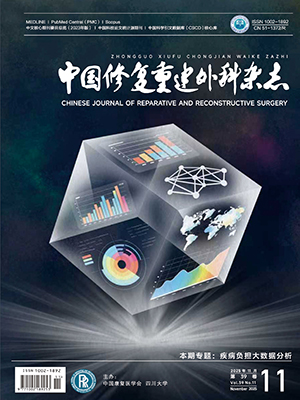Objective To investigate the effect factors of knee function recovery after operation in distal femoral fractures. Methods From January 2001 to May 2007, 92 cases of distal femoral fracture were treated. There were 50 males and 42 females, aged 20-77 years old (average 46.7 years old). Fracture was caused by traffic accident in 48 cases, by fall ing from
height in 26 cases, by bruise in 12 cases and by tumble in 6 cases. According to Müller’s Fracture classification, there were 29 cases of type A, 12 cases of type B and 51 cases of type C. According to American Society of Anesthesiologists (ASA) classification, there were 21 cases of grade I, 39 cases of grade II, 24 cases of grade III, and 8 cases of grade IV. The time from injury to operation was 4 hours to 24 days with an average of 7 days. Anatomical plate was used in 43 cases, retrograde interlocking intramedullary nail in 37 cases, and bone screws, bolts and internal fixation with Kirschner pins in 12 cases. After operation, the HSS knee function score was used to evaluate efficacy. Ten related factors were appl ied for statistical analysis, to knee function recovery after operation in distal femoral fractures, such as age, sex, preoperative ASA classification, injury to surgery time, fracture type, treatment, reduction qual ity, functional exercise after operation, whether or not CPM functional training and postoperative compl ications. Results Wound healed by first intention in 88 cases, infection occurred in 4 cases. All patients followed up 16-32 months with an average of 23.1 months. Cl inical union of fracture was achieved within 3-7 months after operation. Extensor device adhesions and the scope of activities of lt; 80° occurred in 29 cases, traumatic arthritis in 25 cases, postoperative fracture displacement in 6 cases, mild knee varus or valgus in 7 cases and implant loosening in 6 cases. According to HSS knee function score, the results were excellent in 52 cases, good in 15 cases, fair in 10 cases and poor in 15 cases with an excellent and
good rate of 72.83%. Single factor analysis showed that age, preoperative ASA classification, fracture type, reduction qual ity, whether or not CPM functional exercise, and postoperative compl ications were significantly in knee function recovery (P lt; 0.05). logistic regression analysis showed that the fracture type, qual ity of reduction, whether or not CPM functional exercise, and age were major factors in the knee joint function recovery. Conclusion Age, preoperative ASA classification, fracture type, reduction qual ity, and whether or not CPM functional training, postoperative compl ications factors may affect the knee joint function recovery. Adjustment to the patient’s preoperative physical status, fractures anatomic reduction and firm fixation, early postoperative active and passive functional exercises, less postoperative compl ications can maximize the restoration of knee joint function.
Citation: BEI Chaoyong,WANG Ruiying,TANG Jicun,LI Qiang.. EFFECT FACTORS ANALYSIS OF KNEE FUNCTION RECOVERY AFTER DISTAL FEMORAL FRACTURE OPERATION. Chinese Journal of Reparative and Reconstructive Surgery, 2009, 23(9): 1053-1057. doi: Copy
Copyright © the editorial department of Chinese Journal of Reparative and Reconstructive Surgery of West China Medical Publisher. All rights reserved




